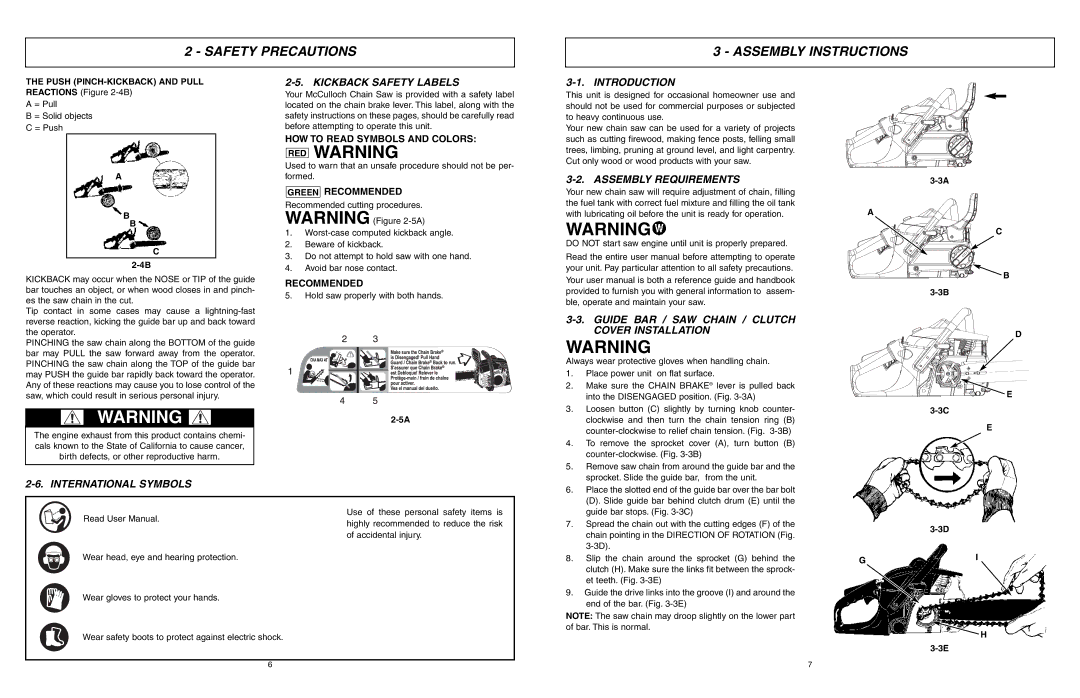
2 - SAFETY PRECAUTIONS
THE PUSH |
|
REACTIONS (Figure | Your McCulloch Chain Saw is provided with a safety label |
A = Pull | located on the chain brake lever. This label, along with the |
B = Solid objects | safety instructions on these pages, should be carefully read |
C = Push | before attempting to operate this unit. |
3 - ASSEMBLY INSTRUCTIONS
3-1. INTRODUCTION
This unit is designed for occasional homeowner use and should not be used for commercial purposes or subjected to heavy continuous use.
Your new chain saw can be used for a variety of projects
A
B
B
C
KICKBACK may occur when the NOSE or TIP of the guide bar touches an object, or when wood closes in and pinch- es the saw chain in the cut.
Tip contact in some cases may cause a
PINCHING the saw chain along the BOTTOM of the guide bar may PULL the saw forward away from the operator. PINCHING the saw chain along the TOP of the guide bar may PUSH the guide bar rapidly back toward the operator. Any of these reactions may cause you to lose control of the saw, which could result in serious personal injury.
WARNING ![]()
The engine exhaust from this product contains chemi- cals known to the State of California to cause cancer, birth defects, or other reproductive harm.
HOW TO READ SYMBOLS AND COLORS:
RED WARNING
Used to warn that an unsafe procedure should not be per- formed.
GREEN RECOMMENDED
Recommended cutting procedures.
WARNING (Figure
1.
2.Beware of kickback.
3.Do not attempt to hold saw with one hand.
4.Avoid bar nose contact.
RECOMMENDED
5.Hold saw properly with both hands.
such as cutting firewood, making fence posts, felling small trees, limbing, pruning at ground level, and light carpentry. Cut only wood or wood products with your saw.
3-2. ASSEMBLY REQUIREMENTS
Your new chain saw will require adjustment of chain, filling the fuel tank with correct fuel mixture and filling the oil tank with lubricating oil before the unit is ready for operation.
WARNING![]()
DO NOT start saw engine until unit is properly prepared.
Read the entire user manual before attempting to operate your unit. Pay particular attention to all safety precautions. Your user manual is both a reference guide and handbook provided to furnish you with general information to assem- ble, operate and maintain your saw.
3-3. GUIDE BAR / SAW CHAIN / CLUTCH COVER INSTALLATION
WARNING
Always wear protective gloves when handling chain.
1. | Place power unit on flat surface. |
2. | Make sure the CHAIN BRAKE® lever is pulled back |
| into the DISENGAGED position. (Fig. |
3. | Loosen button (C) slightly by turning knob counter- |
| clockwise and then turn the chain tension ring (B) |
| |
4. | To remove the sprocket cover (A), turn button (B) |
| |
5. | Remove saw chain from around the guide bar and the |
| sprocket. Slide the guide bar, from the unit. |
6. | Place the slotted end of the guide bar over the bar bolt |
| (D). Slide guide bar behind clutch drum (E) until the |
A
C
B |
D
E |
E
Read User Manual.
Use of these personal safety items is highly recommended to reduce the risk of accidental injury.
guide bar stops. (Fig. |
7. Spread the chain out with the cutting edges (F) of the |
chain pointing in the DIRECTION OF ROTATION (Fig. |
Wear head, eye and hearing protection.
Wear gloves to protect your hands.
Wear safety boots to protect against electric shock.
6
8. | Slip the chain around the sprocket (G) behind the |
| clutch (H). Make sure the links fit between the sprock- |
| et teeth. (Fig. |
9. | Guide the drive links into the groove (I) and around the |
| end of the bar. (Fig. |
NOTE: The saw chain may droop slightly on the lower part of bar. This is normal.
7
G
I
H
